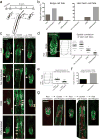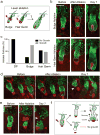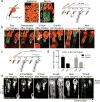Spatial organization within a niche as a determinant of stem-cell fate
- PMID: 24097351
- PMCID: PMC3895444
- DOI: 10.1038/nature12602
Spatial organization within a niche as a determinant of stem-cell fate
Abstract
Stem-cell niches in mammalian tissues are often heterogeneous and compartmentalized; however, whether distinct niche locations determine different stem-cell fates remains unclear. To test this hypothesis, here we use the mouse hair follicle niche and combine intravital microscopy with genetic lineage tracing to re-visit the same stem-cell lineages, from their exact place of origin, throughout regeneration in live mice. Using this method, we show directly that the position of a stem cell within the hair follicle niche can predict whether it is likely to remain uncommitted, generate precursors or commit to a differentiated fate. Furthermore, using laser ablation we demonstrate that hair follicle stem cells are dispensable for regeneration, and that epithelial cells, which do not normally participate in hair growth, re-populate the lost stem-cell compartment and sustain hair regeneration. This study provides a general model for niche-induced fate determination in adult tissues.
Figures




References
Publication types
MeSH terms
Grants and funding
LinkOut - more resources
Full Text Sources
Other Literature Sources
Medical

